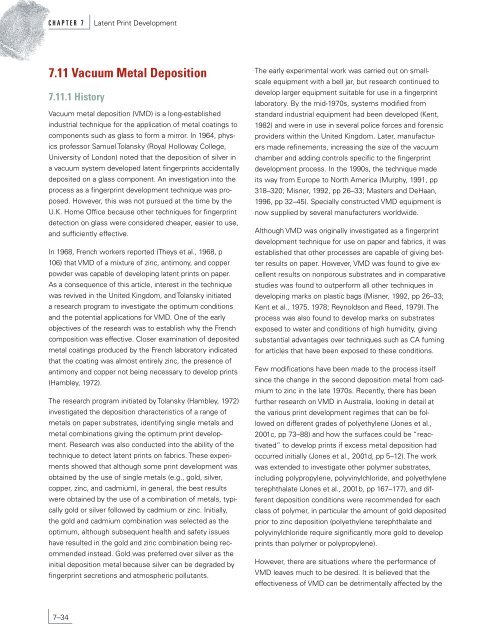Latent Print Development - National Criminal Justice Reference ...
Latent Print Development - National Criminal Justice Reference ...
Latent Print Development - National Criminal Justice Reference ...
You also want an ePaper? Increase the reach of your titles
YUMPU automatically turns print PDFs into web optimized ePapers that Google loves.
C H A P T E R 7 <strong>Latent</strong> <strong>Print</strong> <strong>Development</strong><br />
7.11 Vacuum Metal Deposition<br />
7.11.1 History<br />
Vacuum metal deposition (VMD) is a long-established<br />
industrial technique for the application of metal coatings to<br />
components such as glass to form a mirror. In 1964, phys-<br />
ics professor Samuel Tolansky (Royal Holloway College,<br />
University of London) noted that the deposition of silver in<br />
a vacuum system developed latent fingerprints accidentally<br />
deposited on a glass component. An investigation into the<br />
process as a fingerprint development technique was pro-<br />
posed. However, this was not pursued at the time by the<br />
U.K. Home Office because other techniques for fingerprint<br />
detection on glass were considered cheaper, easier to use,<br />
and sufficiently effective.<br />
In 1968, French workers reported (Theys et al., 1968, p<br />
106) that VMD of a mixture of zinc, antimony, and copper<br />
powder was capable of developing latent prints on paper.<br />
As a consequence of this article, interest in the technique<br />
was revived in the United Kingdom, and Tolansky initiated<br />
a research program to investigate the optimum conditions<br />
and the potential applications for VMD. One of the early<br />
objectives of the research was to establish why the French<br />
composition was effective. Closer examination of deposited<br />
metal coatings produced by the French laboratory indicated<br />
that the coating was almost entirely zinc, the presence of<br />
antimony and copper not being necessary to develop prints<br />
(Hambley, 1972).<br />
The research program initiated by Tolansky (Hambley, 1972)<br />
investigated the deposition characteristics of a range of<br />
metals on paper substrates, identifying single metals and<br />
metal combinations giving the optimum print develop-<br />
ment. Research was also conducted into the ability of the<br />
technique to detect latent prints on fabrics. These experi-<br />
ments showed that although some print development was<br />
obtained by the use of single metals (e.g., gold, silver,<br />
copper, zinc, and cadmium), in general, the best results<br />
were obtained by the use of a combination of metals, typi-<br />
cally gold or silver followed by cadmium or zinc. Initially,<br />
the gold and cadmium combination was selected as the<br />
optimum, although subsequent health and safety issues<br />
have resulted in the gold and zinc combination being rec-<br />
ommended instead. Gold was preferred over silver as the<br />
initial deposition metal because silver can be degraded by<br />
fingerprint secretions and atmospheric pollutants.<br />
7–34<br />
The early experimental work was carried out on small-<br />
scale equipment with a bell jar, but research continued to<br />
develop larger equipment suitable for use in a fingerprint<br />
laboratory. By the mid-1970s, systems modified from<br />
standard industrial equipment had been developed (Kent,<br />
1982) and were in use in several police forces and forensic<br />
providers within the United Kingdom. Later, manufactur-<br />
ers made refinements, increasing the size of the vacuum<br />
chamber and adding controls specific to the fingerprint<br />
development process. In the 1990s, the technique made<br />
its way from Europe to North America (Murphy, 1991, pp<br />
318–320; Misner, 1992, pp 26–33; Masters and DeHaan,<br />
1996, pp 32–45). Specially constructed VMD equipment is<br />
now supplied by several manufacturers worldwide.<br />
Although VMD was originally investigated as a fingerprint<br />
development technique for use on paper and fabrics, it was<br />
established that other processes are capable of giving bet-<br />
ter results on paper. However, VMD was found to give ex-<br />
cellent results on nonporous substrates and in comparative<br />
studies was found to outperform all other techniques in<br />
developing marks on plastic bags (Misner, 1992, pp 26–33;<br />
Kent et al., 1975, 1978; Reynoldson and Reed, 1979). The<br />
process was also found to develop marks on substrates<br />
exposed to water and conditions of high humidity, giving<br />
substantial advantages over techniques such as CA fuming<br />
for articles that have been exposed to these conditions.<br />
Few modifications have been made to the process itself<br />
since the change in the second deposition metal from cad-<br />
mium to zinc in the late 1970s. Recently, there has been<br />
further research on VMD in Australia, looking in detail at<br />
the various print development regimes that can be fol-<br />
lowed on different grades of polyethylene (Jones et al.,<br />
2001c, pp 73–88) and how the surfaces could be “reac-<br />
tivated” to develop prints if excess metal deposition had<br />
occurred initially (Jones et al., 2001d, pp 5–12). The work<br />
was extended to investigate other polymer substrates,<br />
including polypropylene, polyvinylchloride, and polyethylene<br />
terephthalate (Jones et al., 2001b, pp 167–177), and dif-<br />
ferent deposition conditions were recommended for each<br />
class of polymer, in particular the amount of gold deposited<br />
prior to zinc deposition (polyethylene terephthalate and<br />
polyvinylchloride require significantly more gold to develop<br />
prints than polymer or polypropylene).<br />
However, there are situations where the performance of<br />
VMD leaves much to be desired. It is believed that the<br />
effectiveness of VMD can be detrimentally affected by the

















